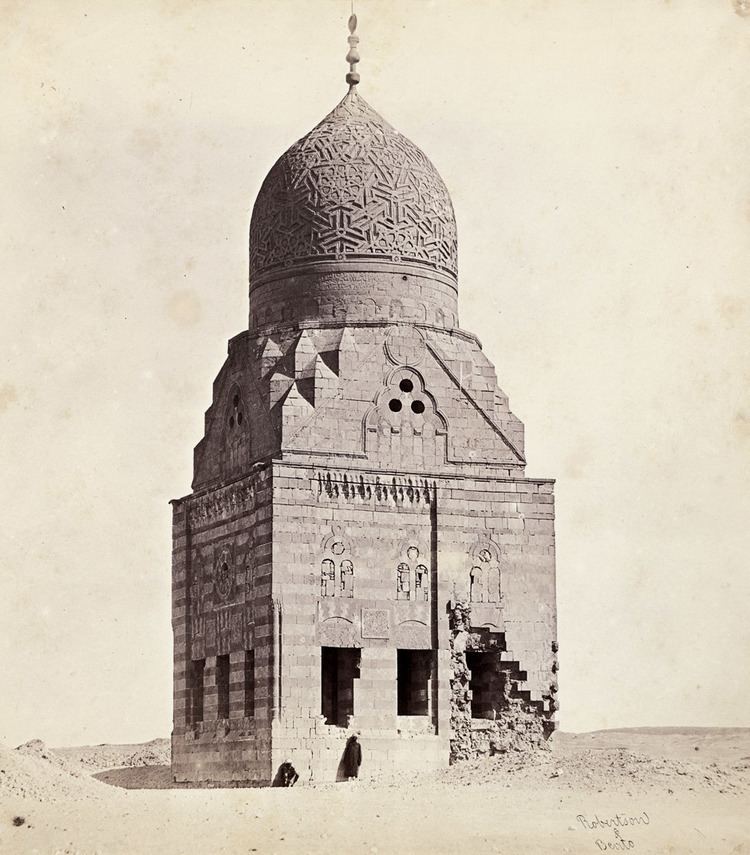 | ||
The Burji dynasty (Arabic: المماليك البرجية) was a Circassian Mamluk dynasty which ruled Egypt from 1382 until 1517, during the Mamluk Sultanate. It proved especially turbulent, with short-lived sultans. Political power-plays often became important in designating a new sultan. During this time Mamluks fought Timur Lenk and conquered Cyprus. Constant bickering may have contributed to the ability of the Ottomans to challenge them. Their name means 'of the tower', referring to them ruling from the Citadel east of Cairo.
Contents
History
From 1250 Egypt had been ruled by the first Mamluk dynasty, the mostly Cuman-Kipchak Turkic Bahri dynasty. In 1377 a revolt broke out in Syria which spread to Egypt, and the government was taken over by the Circassians Barakah and Barquq; Barquq was proclaimed sultan in 1382, ending the Bahri dynasty. He was expelled in 1389 but recaptured Cairo in 1390. Early on, the Zahiri Revolt threatened to overthrow Barquq though the conspiracy was discovered before agitators could mobilize. Permanently in power, he founded the Burji dynasty.
Faced with a common enemy, Timur, Barquq joined with Bayezid I and Toktamish in a combined resistance and executed Timur's peace envoys. In the following months Timur was engaged in Georgia and unable to respond to Barquq's actions, while Barquq had died by 1399. In 1401, Timur invaded Syria and sacked Aleppo and Damascus. Syria was regained by sultan Nasir-ad-Din Faraj after Timur died in 1405, but Faraj continually faced rebellions from the emirs there and he was forced to abdicate in 1412.
In 1421 Egypt was attacked by the Kingdom of Cyprus, and although the Egyptians were unable to capture the island they forced the Cypriotes to acknowledge the suzerainty of the Egyptian sultan Barsbay. During Barsbay's reign Egypt's population was greatly reduced from what it had been a few centuries before, with only 1/5 the number of towns. He frequently raided Asia Minor, but died in 1438.
During the reign of Sayf-ad-Din Jaqmaq an attempt to conquer Rhodes in 1444 from the Knights of St. John was repelled.
Sayf ad-Din Inal came to power in 1453 and had friendly relations with the Ottoman sultan Mehmed II, who captured Constantinople later that year, causing great rejoicings in Egypt. However, under the Greek reign of Khoshkadam, who took power in 1463, Egypt began the struggle between the Egyptian and the Ottoman sultanates which finally led to the incorporation of Egypt in the Ottoman Empire. Both Koshkadam and Mehmed II supported different candidates to the principality of Karaman; then in 1467 sultan Kait Bey offended the Ottoman sultan Bayezid II, whose brother was poisoned while being entertained by Kait. Bayezid II seized Adana, Tarsus and other places within Egyptian territory, but was eventually defeated by Kait. Kait also tried to help the Muslims in Spain by threatening the Christians in Syria, but without effect. He died in 1496, leaving several hundred thousand ducats debts to the great Venetian trading families.
List of Burji Sultans
Conquest by Ottomans
In 1515 there began the war with the Ottoman sultan Selim I which led to the incorporation of Egypt and its dependencies into the Ottoman Empire. A result of the Mamluk cavalry .charges proving to be no match for the Ottoman artillery and the janissaries. Egyptian sultan Kansuh was charged by Selim with giving the envoys of the Safavid Ismail passage through Syria on their way to Venice to form a confederacy against the Turks, and with harbouring various refugees. At the Battle of Merj Dabik, on August 24, 1515, Kansuh was killed in the fighting. Syria passed into Turkish possession, who were welcomed in many places as deliverance from the Mamelukes.
In 1517 the Ottoman Turks and their sultan Selim I defeated the Mamluks with the capture of Cairo on January 20. The centre of power transferred from Cairo to Constantinople. However, the Ottoman Empire retained the Mamluks as an Egyptian ruling class and the Mamluks and the Burji family succeeded in regaining much of their influence, but remained technical vassals of the Ottomans.
